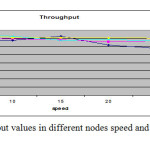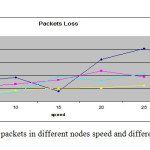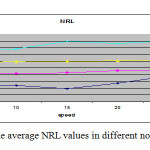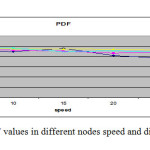Mohammed Saad Talib1 and Zainab Saad Talib2
1MSc. Networking, University of Babylon, Iraq.
2BSc. Eng. Software, University of Kerbela, Iraq.
Article Publishing History
Article Received on :
Article Accepted on :
Article Published : 03 Jul 2014
Article Metrics
ABSTRACT:
Simulation techniques are being the most important tool that can be used in verification, test and implementation of the Mobile Ad-hoc Network (MANET) environments. These computerized techniques can be feasibly used as a virtual tool to model and operate any suggested environment. MANET was defined “as a set of mobile nodes that moved freely and connected among each other without any infrastructure”. Simulation represents a good reliable tool that can be used to evaluate the performance of an existing or proposed MANET environment under different configurations along periods of real time. In this paper certain MANET’s environment was simulated and operated with AOMDV routing Protocol. The effects of the number of nodes, their speeds and their pause times were modeled and analyzed. The network simulator NS-2 was used as a tool to study and evaluate the effects of these factors. Many performance metrics such as throughput, packets loss, packet delivery fraction (PDF), average end-to-end delay, normalize routing load (NRL) and jitter were used as comparison indications. The simulation environment was implemented with different number of nodes, different speeds, and varying pause times. Significant effects and relations between all these parameters and performance metrics were found and calculated.
KEYWORDS:
Simulation, performance evaluation, AOMDV, MANET
Copy the following to cite this article:
Talib M. S, Talib Z. S. Simulate and Model MANETs Environment with AOMDV Routing Protocol. Orient. J. Comp. Sci. and Technol;7(1)
|
Copy the following to cite this URL:
Talib M. S, Talib Z. S. Simulate and Model MANETs Environment with AOMDV Routing Protocol. Orient. J. Comp. Sci. and Technol;7(1). Available from: http://computerscijournal.org/?p=722
|
Introduction
Mobile Ad hoc network (MANET) is a collection of wireless mobile nodes that can be set up anywhere, anytime and connected via wireless link without using an existing of any fixed infrastructure. MANET is formed dynamically by an autonomous system of mobile nodes. These nodes are wirelessly connected. It represents a dynamic distributed system of arbitrarily moving wireless devices. MANET capabilities and its applications are becoming an important part of overall the current and the next-generation of wireless network functionalities. In MANET, the nodes are free to move randomly while it communicates and can connected to each other randomly as well as organize themselves arbitrarily [1].
Such network’s topology may change rapidly and unpredictably.Each mobile node can have one or more network interface, each of which is attached to a channel. Channels are the carrier that carrying packets between mobile nodes. When a mobile node transmits a packet to a channel, the channel distributes a copy of the packet to the other entire network interface on the channel. These interfaces then use a radio propagation model to determine if they are actually able to receive the packet [2].
Each of the nodes has a wireless interface and communicates with each other over a radio transmission range [3]. A MANETs might consist of several home-computing devices, including cellular phone, PDAs, laptops, MP3 player, notebooks, handheld PCs and so on. These nodes can be located in cars, ships, airplanes as well as other small personal electronic devices. Each node will be able to communicate directly with other nodes that reside within its transmission range. For communicating with nodes that reside beyond this range, the node needs to use intermediate nodes to replay messages hop by hop [4].
Modeling
Modeling is the process of building a model to represent the actual system with some simplifying assumptions. This process is to help the designers or the users to experiment, test and change the system parameters to indicate their effects and their relations to each other. Such process can be done without any effects on the real system as an economical virtual scientific manner. It can save costs in system development if the modeling process is properly handled. In the system design and development stages, the modeling is important to give an idea of how the system would perform if it actually implemented. In this paper, the modeling process was used to model and represent different proposed MANET’s configurations environments.
Simulation
Simulation is “Imitating or estimating how events might occur in a real situation”. It is widely used to analyze, develop and test different topologies, different new protocols and different architectures in the field of networks and communications. This technique offers a good laboratory to simulate and specify the behavior of the network nodes and the communication channels. Simulation methodology is always applied and used to verify analytical models, list the results of the measurements and to test and evaluate the suggested new protocols performance compared with the existing protocols. One of the main objectives of network simulation is to study network performance [5] [6].
Due to the complexity, impossibility of experimenting on real networks and high costs, the simulation methodology has become the most popular technique in computer and telecommunication network researches and developments. It can be used to verify analytical models, generalize the measurement results, evaluate the performance of new protocols that are being developed, as well as to compare the existing protocols [5]. These simulators principally aim to model the network systems by changing the features of its built models in order to analyze its corresponding results. It can be applied in an efficient manner to test, analyze and evaluate different purposes of engineering, sciences and other general application systems. One of the available Network Simulators is the discrete event-based simulator called (NS-2) which is one of the most popular academic tools that can be used in evaluating the network topology and protocols. Due to its open source nature, NS-2 can be easily extended and modified. NS-2 is a software package developed for network simulation. It covers a very large number of applications, protocols, network types, network elements, and traffic models [7].
Simulation Methodology
Simulation technique is the most suitable technique that can be used to get detailed information about the MANETs operation. It helps in studying a system in repeatability well-known conditions in order to understand the system mutual activities and events [8]. To evaluate the performance of certain existed or suggested communication system, a Network Simulator NS-2 can be used to present and estimate the required main important communication network parameters and metrics [9].
Performance evaluation
There are three possible techniques used to evaluate the network performance; analytical modeling, simulation and measurement. In the case of complex and expensive problems (such as communication networks); experimentation, test and operation is very difficult in the real systems. In the case of the new designed systems, there are many challenges such as; unavailability of data, limited times available for evaluation and highly cost required for real system allocation. Due to these reasons and others, a suitable available technique can be utilized which is “the Simulation technique” [10].
The dynamic topology, time-varying, bandwidth constrained, wireless channels, multi-hops routing, and distributed control and management are the main inherent characteristics of the MANETs. The design and performance analysis of routing protocols for (MANET) is currently an active and crucial area of research. In this study the AOMDV routing protocol was studied and analyzed. Many performances metrics can be used to compare and evaluate the available or the suggested MANET’s performance [11].
There are several important criteria that can be used for Performance evaluation of a real network. It means how well a network runs such as availability, reliability, response time, utilization, throughput, bandwidth capacity, and packet loss ratio [7].
Many performance metrics were developed and adopted to measure and evaluate the performance of the MANET networks. All of the measuring performance processes requires the use of statistical modeling to estimate these parameters values [12]. In this article, six evaluation metrics were estimated and utilized to compare and evaluate the effects and behaviors of the MANET parameters and variables related to nodes speed and nods pause times. These important performance metrics are:
Throughput, which is measured as [13]:
Throughput = receive packets / simulation time
Dropped Packets [15] ,
Dropped packets = sent packets(i) – received packets(i)
Average end-to-end delay (average E2E delay) [3][16] ,
E2E delay [packet_id] = received time [packet_id] – sent time [packet_id]
Normalize Routing Load (NRL) [10][17],
NRL = number of routing packets/ number of received packets
Packet delivery fraction (PDF) [8],
PDF = (number of received packets / number of sent packets) * 100
Average Jitter [18],
Jitter = | (end-to-end delay (k+1)) – (end-to-end delay (k))|
Simulation Environment
The following suggested simulation environment was built and simulated in this study. The Network Simulator (NS-2) was used as a simulation tool in this article.
This environment aims to study and analyze the effect of the nodes number and their average speeds on the general behavior of the MANET. Such effect can observed through the simulated values of many output performance metrics which are (packets loss, throughput, delay, NRL, PDF and Jitter). Many variables or (parameters) were set to be fixed during all the simulation runs in this suggested MANET’s environment. Certain arbitrary values were assigned to the simulation area, traffic type, simulation time, pause time and maximum number of connections. The AOMDV routing protocol was used as a main routing protocol in all the implemented scenarios. Table (1) shows the proposed MANET’s parameters and their assigned values.
Results
Each simulation environment was implemented and repeated 50 times in order to get near reliable stable results. The effects of varying the nodes number and speed were observed by varying the number of nodes and their speeds. Packet delivery fraction, routing load, dropped packets, average jitter, average end to end delay and throughput were calculated with the AOMDV routing protocol. The results were plotted in the following figures; each point in the following graphs represents the average of 50 scenario runs. This environment was evaluated and simulated to indicate the effects of the number of nodes and their speeds on the behavior of the MANET. Each run was repeated 50 times and the average value for each metric were estimated. Fig. 1 shows the lost packets in different nodes speed and different number of nodes (5, 10, 15 and 20). The number of the lost packets was decreased with increasing the number of nodes in low speed. It will be increased with increasing the nodes speed. The best situation is to let the nodes speed below 17 m/sec and the best suitable number of nodes for such area is 15 nodes.
In fig. 2 we tried to show the throughput values with different nodes speed and different number of nodes.
 |
Fig2: throughput values in different nodes speed and different number of nodesThe best network throughput shown by this graph is to let the nodes speed below 17 m/sec for any used number of nodes. There are no significant differences between the network throughputs at these speeds.
Click here to View Figure
|
Fig. 3 shows the average end to end delay values with different nodes speed and different number of nodes.
This graph shows that the values of the end to end delay will be high with small number of nodes and decreased with increasing number of nodes at low speeds (less than 15 m/sec). The end to end delay values were increased with increasing speeds. As an average the speed value of 15 m/sec is the best value for this metric for any number of nodes in this area.
The values of the NRL will seemed to be reduced with the small number of nodes and increased with increasing number of nodes at each speed. NRL values were slightly increased with increasing speeds. The speed value below 15 m/sec is seemed to be the best value for this metric for any number of nodes in this area.
There are no significant differences between the PDF values for any number of nodes with speeds less than 15 m/sec. The PDF values will decrease with increasing the nodes speed.
While fig. 6 shows the Jitter values with different nodes speed and different number of nodes.
From this graph, the jitter values seemed to be decreased with increasing number of nodes. The speed value of 15 m/sec is also a critical value in which a change will happen.
Conclusions
The main aim of this paper is to discuss the most relevant issues of MANETs, from the application viewpoints. These applications depend on different factors. The selected factors are the number of nodes, the nodes speed and the nodes pause times with AOMDV routing Protocol. The effects of nodes number and nodes speed were studied and analyzed in many scenarios in order to estimate the best number of nodes and best possible speed for any new designed MANET. This study was devoted to discuss the constraints that must be satisfied by the MANET and the different aspects that must be taken into consideration in the designing of a new MANET.
The number of the lost packets was decreased with increasing the number of nodes in low speed. It will be increased with increasing the nodes speed. The best situation is to let the nodes speed below 17 m/sec and the best suitable number of nodes for such area is 15 nodes. The best network throughput shown by this graph is to let the nodes speed below 17 m/sec for any used number of nodes. There are no significant differences between the network throughputs at these speeds. The end to end delay will be high with small number of nodes and decreased with increasing number of nodes at low speeds (less than 15 m/sec). its values were found to be increased with increasing speeds. As an average the speed value of 15 m/sec is the best value for this metric for any number of nodes in this area. The NRL will seem to be reduced with the small number of nodes and increased with increasing the number of nodes at each speed. NRL values were slightly increased with increasing speeds. The speed value below 15 m/sec is seemed to be the best value for this metric for any number of nodes in this area. There are no significant differences seen between the PDF values for any number of nodes with speeds less than 15 m/sec. The PDF values will be decreased with increasing the nodes speed. The jitter values seemed to be decreased with increasing number of nodes. The speed value of 15 m/sec is also a critical value in which a change will be happen.
References
- Verdone, R.; Dardari, D.; Mazzini, G.; Conti, A. Wireless Sensor and Actuator Networks; Elsevier:London, UK, 2008.
CrossRef
- D. b. Johnson, Josh Broch, Yih-Chun Hu, Jorjeta Jetcheva and David A.Maltz, “The CMU Monarch Project ‘s Wireless and Mobility Extensions to ns”, computer science department Carnegie mellon university Pittsburgh, 1999 avilable [Online] : http://www.monarch.cs.cmu.edu/.
- Tachtatzis, Christos and Harle, D.A., “Performance evaluation of multi-path and single-path routing protocols for mobile Ad-Hoc networks” In: International Symposium on Performance Evaluation of Computer and Telecommunication Systems, IEEE Xplore, pp. 173-180, ISBN 978-1-56555-320-9, 2008.
- Basagni, S.; Conti, M.; Giordano, S.; Stojmenovic, I. Mobile Ad Hoc Networking; Wiley: San Francisco, CA, USA, 2004.
CrossRef
- Sarkar, N.I. (2011) ‘A Review of Simulation of Telecommunication Networks: Simulators, Classification, Comparison, Methodologies, and Recommendations’, Multidisciplinary Journals in Science and Technology, Journal of Selected Areas in Telecommunications (JSAT), March, pp. 10-17.
- Bradley Jee and Kiran Mani, ” On the Edge: A Comprehensive Guide to Blade Server Technology”; John Wiley & Sons (Asia) pre Ltd; 2007.
- Xue, Y., Lee, H.S., Yang, M., Kumarawadu, P., Ghenniwa, H.H. and Shen, W. (2007) ‘Performance Evaluation of NS-2 Simulator for Wireless Sensor Networks’, Department of Electrical and Computer Engineering, Faculty of Engineering, The University of Western Ontario, London, ON, Canada, 1372-1375.
CrossRef
- Mohd Saad, M.I. and Zukarnain, Z.A. (2009) ‘Performance Analysis of Random-Based Mobility Models in MANET Routing Protocol’, European Journal of scientific Research, vol. 32, no. 4, pp. 444-454.
- Kumar, V. (2009) ‘Simulation and comparison of AODV and DSR Routing Protocols in MANETs’, Master Thesis.
- Murty, M.S. and Das, M.V. (2011) ‘Performance Evaluation of MANET Routing Protocols using Reference Point Group Mobility and Random Way Point Models’, International Journal of Ad hoc, Sensor & Ubiquitous Computing (IJASUC), vol. 2, no. 1, March.
- Singla, V., Singla, R. and Kumar, A. (2009) ‘Performance Evaluation and Simulation of Mobile Ad-hoc Network Routing Protocols’, IJEIT, vol. 1, no. 1, October, pp. 49-53.
- Odge, “The Oxford Dictionary of Statistical Terms”, OUP. ISBN0-19-920613-9, 2003,http://www.bth.se/fou/cuppsats.nsf/all/.
- Bansal, R.K. (2006) Performance analysis of cluster based routing protocol in MANETs, DEEMED UNIVERSITY, PATIALA – 147004.
- Timcenko, V., Stojanovic, M. and Rakas, S.B. (2009) ‘MANET Routing Protocols vs. Mobility Models: Performance Analysis and Comparison’, Proceedings of the 9th WSEAS. International Conference on Applied Informatics and Communications (AIC ’09), SERBIA, 271-276.
- Aliff Umair Salleh, Zulkifli Ishak , Norashidah Md. Din and Md Zaini Jamaludin, “Trace Analyzer for NS-2”, IEEE, pp. 29-32, Student Conference on Research and Development (SCOReD), Malaysia, 2006.
- Bhattacharya, A. (2007) ‘Flow control of real-time unicast multimedia application in besteffort networks’, PhD thesis.
- Beaubrun, R. and Molo, B. (2010) ‘Using DSR for routing Multimedia Traffic in MANETs’, International Journal of Computer Networks & Communications (IJCNC), vol. 2, no. 1, January, pp. 120-138.
- Ravi Kumar Bansal, “Performance Analysis of Cluster based Routing Protocol in MANETs”, Computer Scienece and Engineering Departmet thapar Institute of Engineerin and Technology, Patiala-147004, May-2006.

This work is licensed under a Creative Commons Attribution 4.0 International License.







